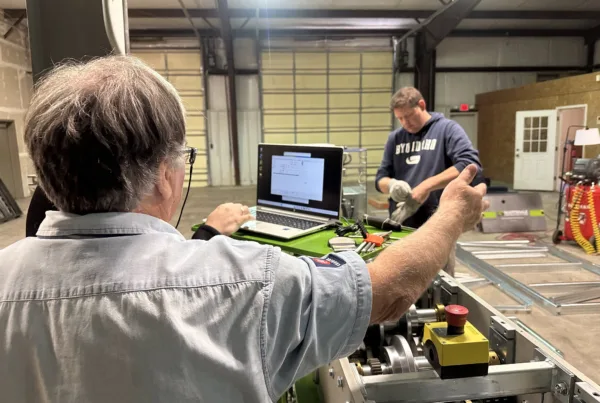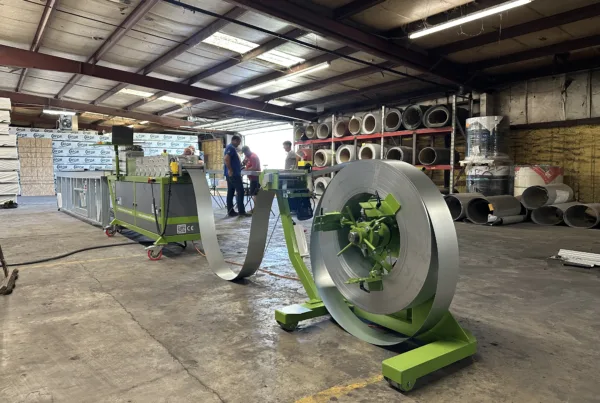Choosing the optimal section profile in cold-formed steel framed construction is critical in achieving the maximum strength from the various structural elements such as walls, trusses and floor joists within steel framed buildings. This article will cover different aspects of using optimized cold-formed steel profiles, C-section or Hat-section, their advantages, the effects of stiffeners on the buckling mode of failure, and the benefits of using the same member profile within buildings. Furthermore, this article will touch on how Scottsdale profiles are optimized for the benefit of our customers.
Cold-Formed Steel Geometry Optimization
The geometry of the profile plays a crucial role in determining the strength of the profile. Scottsdale and Knudson by Scottsdale series of roll formers are equipped to roll the most commonly used profiles within the cold-formed steel building industry. These include Lipped and Unlipped C-section, Hat sections and Resilient Channel sections.
 Effect of Stiffeners on Buckling Modes of Cold-Formed Steel Members
Effect of Stiffeners on Buckling Modes of Cold-Formed Steel Members
Buckling is an important failure mode in cold-formed steel members and must be accounted for in the design of these light gauge sections. Different buckling modes are to be accounted for and are listed below.
- Local buckling
- Distortional buckling
- Global buckling
- Flexural
- Torsional
- Flexural-Torsional
During the design process check against all these above-mentioned buckling modes must be carried out as per the corresponding country code of practice. However, these buckling modes are governed by the profile shape and the corresponding stiffeners within them. Some buckling modes on different profile shapes are shown in the image below.
As shown above, the thin-walled light gauge steel sections can exhibit multiple buckling behaviors depending upon the location and depth of the stiffeners. Various stiffeners used in the C-section profile are shown below.
It is also worthwhile to note that the lips in both the C and Hat sections also contribute to the various buckling modes and behavior of these sections within the design process. The buckling modes are numerically determined by the use of Finite Strip Analysis or Finite Element Analysis and are represented as empirical equations in various country codes of practice. These equations can then be used in determining the capacity of these sections using the Effective Width Method (EWM) or Direct Strength Method (DSM) using the respective country code of practice. The next section details the differences is strengths between the usage of various stiffeners within the C-section profile.
Influence of Stiffeners in Cold-Formed Steel Section Strength
For this example, the section strengths for the above-mentioned C-section profile are determined using AISI S100-16/S3-22, LRFD using the Effective Width Method (EWM).
All three sections are created with the same area and flat width for this comparison as shown in the section properties data above. The following strengths are considered for this comparison to highlight the influence of the web stiffeners on section strength.
- Axial Tension, ϕTn
- Axial Compression, ϕPno
- Bending about positive X-axis, ϕMnxo
- Bending about negative X-axis, ϕMnxo
- Bending about positive Y-axis, ϕMnyo
- Bending about negative Y-axis, ϕMnxo
- Shear about X and Y-axes, ϕVnx and ϕVny
- Torsion, ϕBn
Note: The strengths considered for comparison are the section strengths wherein the effect of length is ignored.
The image below shows the summary of all the strengths of the C-section profile with various stiffener options.
The table below provides a comparison of the different stiffener types within the C-section profile.
| Strength | 2-Stiffener vs. Plain | 2-Stiffener vs. Sigma | Sigma vs. Plain | Sigma vs. 2-Stiffener |
| ϕPno | 12% | 15% | 28% | 15% |
| ϕTn | 0% | 0% | 0% | 0% |
| ϕVny | 25% | 8% | 34% | 8% |
| ϕVnx | 0% | 0% | 0% | 0% |
| ϕMnxo, positive | -14% | 0% | -15% | 0% |
| ϕMnxo, negative | -14% | 0% | -15% | 0% |
| ϕMnyo, positive | -9% | -4% | -12% | -4% |
| ϕMnyo, negative | -5% | -4% | -9% | -4% |
| ϕBn | -6% | 5% | -1% | 5% |
Axial Tension
The axial tension capacity, ϕTn for the C-section with various web stiffeners is computed as follows.
- C-section with two web stiffeners = 81.058 kN
- C-section with sigma web stiffeners = 81.055 kN
- Plain C-section = 80.952 kN
It is evident that there is no significant change in the axial tension capacities among the three combinations. Therefore, we can infer that the effect of stiffener has very little effect on the axial tension capacity of the section. This is attributed to a similar gross section area used in the effective width calculation in EWM.
Axial Compression
The axial compression capacity, ϕPno for the C-section with various web stiffeners is computed as follows.
- C-section with two web stiffeners = 87.92 kN
- C-section with sigma web stiffeners = 101.1 kN
- Plain C-section = 78.78 kN
The hierarchy of compression capacities is Sigma Web Stiffeners > Two Web Stiffeners > Plain section. This is attributed to the effective width calculation where the bends in the sigma section contribute to greater effective lengths as there is more section effective closer to the section centroid. C-section with Sigma web stiffeners results in 28% more axial compression capacities in comparison with plain C-sections. On the contrary, the C-section with two web stiffeners results in a 12% increase in axial compression capacity. Therefore, the depth of the stiffeners plays a major role in the increased axial compression capacity.
Bending about Positive X-axis
The bending capacity, ϕMnxo about positive X-axis for the C-section with various web stiffeners is computed as follows.
- C-section with two web stiffeners = 4.152 kNm
- C-section with sigma web stiffeners = 4.148 kNm
- Plain C-section = 4.8552 kNm
The hierarchy of bending capacities about positive X-axis is Plain section> Two Web Stiffeners > Sigma Web Stiffeners. In the computation of positive bending strength about the X-axis the plain C-section results in higher capacity. This is because of the reduction in effective sections along the web in sections with stiffeners. As the plain section has a flat web, the effective area is higher thereby resulting in higher capacity. However, the difference is around 14% for both stiffener types and is consistent in comparison with the plain C-section. Therefore, it can be inferred that the axial compression strength gain has a side effect of a slightly reduced bending capacity of the section about the positive X-axis.
Bending about Negative X-axis
The bending capacity, ϕMnxo about negative X-axis for the C-section with various web stiffeners is computed as follows.
- C-section with two web stiffeners = 4.1525 kN
- C-section with sigma web stiffeners = 4.1488 kN
- Plain C-section = 4.8552 kN
There is no change in the hierarchy or the strength values for the C-section about the negative X-axis. This is attributed to the monosymmetric nature of the profile about the X-axis. Therefore, the C-section behaves the same way in bending about the positive and negative X-axes.
Bending about Positive Y-axis
The bending capacity, ϕMnyo about the positive Y-axis for the C-section with various web stiffeners is computed as follows.
- C-section with two web stiffeners = 0.9109 kNm
- C-section with sigma web stiffeners = 0.8762 kNm
- Plain C-section = 0.9996 kNm
Since the C-section is unsymmetrical about the Y-axis, the computed section strength varies with respect to the Y-axis. The hierarchy of strengths in this instance is Plain section> Two Web Stiffeners > Sigma Web Stiffeners. The reason is similar to that explained in the X-axis where the reduction in bending strength is a result of the increased compressive strength. The effective widths of the elements for bending about the Y-axis are smaller in comparison with bending about the X-axis thereby resulting in lesser strengths in comparison with the X-axis. Hence, the C-section with sigma stiffeners results in 12% lower capacity than the plain C-section because of the reasons explained above.
Bending about Negative Y-axis
The bending capacity, ϕMnyo about negative Y-axis for the C-section with various web stiffeners is computed as follows.
- C-section with two web stiffeners = 0.9091 kNm
- C-section with sigma web stiffeners = 0.8762 kNm
- Plain C-section = 0.9605 kNm
The hierarchy of strengths is Plain section> Two Web Stiffeners > Sigma Web Stiffeners and the pattern remains the same as that of bending about positive Y-axis. Due to the monosymmetric nature of the C-section about the Y-axis as explained above the strength of the C-section with sigma stiffeners results in 9% lower capacity than the plain C-section
Shear about X-axis
The shear capacity, ϕVnx about the X-axis for the C-section with various web stiffeners is computed as follows.
- C-section with two web stiffeners = 23.11 kN
- C-section with sigma web stiffeners = 23.11 kN
- Plain C-section = 23.11 kN
All three sections result in the same shear capacity as the section is monosymmetric about the X-axis. Therefore, the stiffeners do not have any effect on the shear strength about the X-axis.
Shear about Y-axis
The shear capacity, ϕVny about the Y-axis for the C-section with various web stiffeners are computed as follows.
- C-section with two web stiffeners = 31.16 kN
- C-section with sigma web stiffeners = 33.51 kN
- Plain C-section = 24.95 kN
The hierarchy of strengths is Sigma Web Stiffeners > Two Web Stiffeners > Plain section. The contribution of stiffeners does play a significant role resulting in 34% more shear capacity for the C-section with sigma stiffeners in comparison with the plain C-section. On the other hand, the C-section with two stiffeners results in a 25% in shear strength in comparison to the plain C-section. This is a significant boost in strengths and helps govern the design results in many cases.
Torsion of Cold-Formed Steel Member
The torsion capacity, ϕBn for the C-section with various web stiffeners are computed as follows.
- C-section with two web stiffeners = 47869 kN-mm2
- C-section with sigma web stiffeners = 50298 kN-mm2
- Plain C-section = 50982 kN-mm2
The hierarchy of strengths is Plain section >Sigma Web Stiffeners > Two Web Stiffeners. The C-section with sigma stiffeners will result in a 5% strength increase in comparison with the C-section with two web stiffeners. However, there is a slight reduction in strength of 1% in comparison with the plain C-section. This is attributed to the depth of the stiffener and the corresponding bends and location. The Sigma stiffeners are more optimal in providing torsional strength to the section in comparison with the C-section which has only two intermittent web stiffeners.
Summary and Conclusions
- Sigma stiffeners provide significantly higher axial compression capacities in comparison with plain sections and C-sections with two intermittent web stiffeners. Therefore, they are well suited to be used in load-bearing walls.
- The minor reduction in bending capacities is compensated by the increased axial compression and shear capacities about their corresponding axes. This can be particularly helpful in walls where combined axial and bending actions govern the design.
- Bending action about any given axis is accompanied by shear about the perpendicular axis. Therefore, in our case, the minor loss in strength under bending is compensated by the significant increase in shear strength.
- Stiffeners don’t contribute significantly to the torsional strength. Also, in most practical use cases, the structural elements are supported against torsion by other elements.
Scottsdale’s Approach to Cold-Formed Steel Web Stiffeners
- Scottsdale and Knudson by Scottsdale line of roll formers have the capabilities to roll C-sections with and without web stiffeners. This includes both intermittent web stiffeners (2-stiffeners) and sigma stiffeners.
- Choice of the corresponding section depends on the end use case and all combinations of the stiffeners discussed in this article are supported.
- Our design and engineering software also caters for all the variations in stiffeners for your design and project needs.
- More details about the type of sections can be found in the Scottsdale ecosystem.
- Detailed calculations are available for all stiffener types so that rest assured that the design software utilizes the strength increase in corresponding actions resulting in optimized steel usage for your designs.




